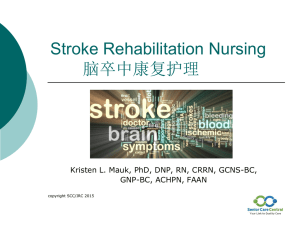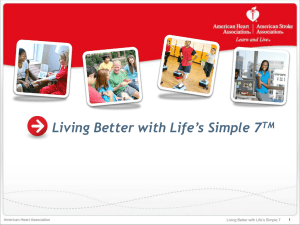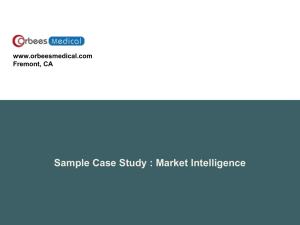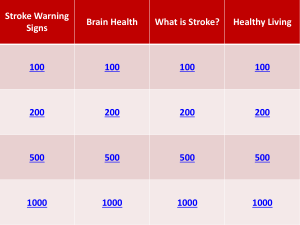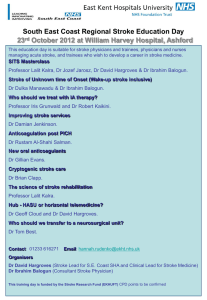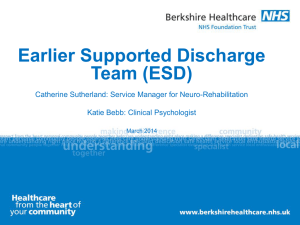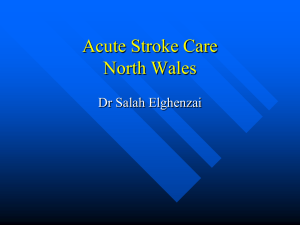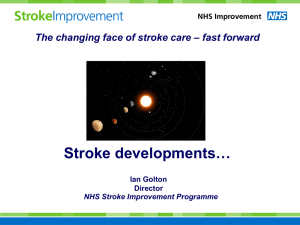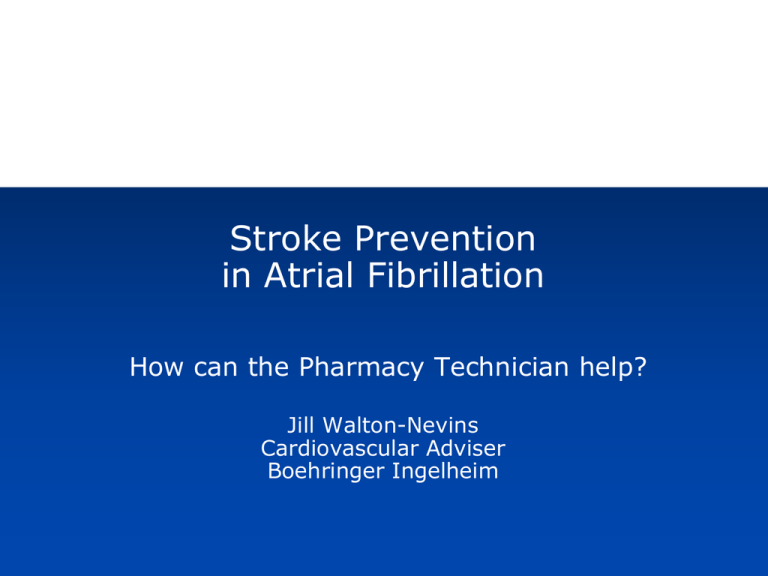
Stroke Prevention
in Atrial Fibrillation
How can the Pharmacy Technician help?
Jill Walton-Nevins
Cardiovascular Adviser
Boehringer Ingelheim
Incidence and prevalence…
AF is the most common heart rhythm disturbance4
It is estimated 1 in 4 individuals aged 40 years will develop
AF4
In 2007, 6.3 million people in the US, Japan, Germany, Italy,
Spain, France and UK were living with diagnosed AF5
Due to the aging population, this number is expected to double
within 30 years6
4. Lloyd-Jones DM, et al. Circulation 2004;110:1042-1046. 5. Decision Resources. Atrial Fibrillation Report. Dec 2008. 6. Go AS, et al. JAMA 2001;285:2370-2375.
Relationship to age…
Projected Number of Persons
With AF in the United States
Between 2000 and 2050
45.00
Men
Women
40.00
40.06
18
35.00
16
28.67
30.00
26.31
25.00
17.69
20.00
12.93
15.00
7.28
10.00
0.00
15.9
11.7
10
8.9
8
4
0.640.21
<55
12
6
4.56
2.37
5.00
14.3
14
Millions
Incidence Rate per 1000 Patient-Years
Age- and Sex-Adjusted
Incidence of AF in 1995-2000
6.7
5.1
2
55-64 65-74 75-84
Age Group (years)
1. Miyasaka Y et al. Circulation. 2006;114:119-125.
≥85
0
2000
2010
2020Year
2030
2040
2050
Risk Factors…
Cardiac
Non-Cardiac
Atrial hypertrophy
Acute infections (pneumonia)
Ischaemic heart disease
Electrolyte imbalances
Rheumatic heart disease
Lung cancer
Hypertension
Pulmonary embolism
Sick sinus syndrome
Thyrotoxicosis
Wolf-parkinson-white
7.Maurits A et al. Pathophysiologyand prevention of atrial fibrillation. Circulation 2001;103:769-777
Types of atrial fibrillation…
Classification of AF subtypes
First diagnosed episode of atrial fibrillation
Paroxysmal
(usually ≤48 Hrs)
Persistent
(requires CV)
Long Standing
(persistent > 1year)
Permanent
(accepted)
11.www.escardio.org/guidlines. European Heart Journal (2010) 31, 2369-2429.
Symptoms…
If sustained AF:
Palpitations +/- Chest pain
Dyspnoea +/- Dizziness
Reduced exercise tolerance (often significant)
Panic attacks/Agoraphobia/depression
If Paroxysmal:
As above, but may be more severe (less well
tolerated)
Often preceded by exertion, ‘thump’ in the chest,
fatigue, alcohol, coffee and other stimulants
12.Weert, H. Diagnosing atrial fibrillation in general practice. BMJ. 2007. 335:355-356.
Primary care…
Perform opportunistic pulse check in those >65 particularly
those patients presenting with:
Breathlessness or dyspnoea
Palpitations
Syncope or dizziness
Chest discomfort
Stroke/TIA
Also perform routinely when monitoring patients with:
Hypertension
Diabetes
Existing cardiovascular disease
Diagnosis…
MANUAL pulse checking will give a
strong clue
‘Irregular irregularity’ – any
rate
Variable strength of
individual pulses
Often omitted since
introduction of automated
BP machines, etc.
12 Lead ECG
NICE – an ECG should be
performed in all patients,
whether symptomatic or not,
in whom AF is suspected
because an irregular pulse
has been detected
Taking the pulse...
The radial pulse…
Very easy to do with practice
2 or 3 fingers (not thumb)
Along radius (in line with the
patient’s thumb)
30 secs usually sufficient
Give it a go!
Stroke risk assessment with CHADS2
CHADS2 criteria
Score
Congestive heart failure
1
Hypertension
1
Age ≥75 yrs
1
Diabetes mellitus
1
Stroke/transient ischaemic
attack
2
CHADS2
total score
Risk of stroke (%/year)
(95% CI)*
0
1.9
(1.2–3.0)
1
2.8
(2.0–3.8)
2
4.0
(3.1–5.1)
3
5.9
(4.6–7.3)
4
8.5
(6.3–11.1)
5
12.5
(8.2–17.5)
6
18.2
(10.5–27.4)
*Adjusted stroke rate = expected stroke rate per 100 patient-years
based on exponential survival model, assuming aspirin not taken
Gage BF et al. JAMA 2001;285:2864–70
Stroke risk assessment with CHA2DS2-VASc
CHA2DS2-VASc criteria
Score
Congestive heart failure/
left ventricular dysfunction
1
CHA2DS2-VASc
total score
0
0
Hypertension
1
1
0.6
(0.0–3.4)
Age 75 yrs
2
2
1.6
(0.3–4.7)
Diabetes mellitus
1
3
3.9
(1.7–7.6)
Stroke/transient ischaemic
attack/TE
2
4
1.9
(0.5–4.9)
Vascular disease
(prior myocardial infarction,
peripheral artery disease or
aortic plaque)
1
5
3.2
(0.7–9.0)
6
3.6
(0.4–12.3)
7
8.0
(1.0–26.0)
8
11.1
(0.3–48.3)
Age 65–74 yrs
1
9
100
(2.5–100)
Sex category (i.e. female
gender)
1
TE = thromboembolism
Lip GYH et al. Chest 2010; 137;263-272.
Rate of stroke/other TE
(%/year) (95% CI)*
(0–0)
*Theoretical rates without therapy corrected for the % of patients
receiving aspirin within each group, assuming 22% reduction in
risk with aspirin
AF – The real cost…
AF is a major independent
risk factor of stroke with the
risk increasing with age 14
Stroke is the third most
common cause of death in
the UK 15
14. NICE AF June 2006. 15. National stroke strategy, Dec 2007.
Any Questions?
Stroke…
‘A clinical syndrome characterised by rapidly developing clinical
symptoms and/or signs of focal and at times global loss of
cerebral function, with symptoms lasting more than 24 hours or
leading to death, with no apparent cause other than that of
vascular origin’. (Hatano 1976)
Warlow C et al. (2008). Stroke Practical Management: 39–40
Defining the difference…
Transient ischaemic attack - TIA
Stroke like symptoms but lasting less than 24
hours.
1
Most last for 15-30 minutes.
1
Symptoms completely resolved once flow returns.
1
Brain is temporarily deprived of blood by tiny emboli
which break up very quickly. “angina of the brain”.
1
TIA’s do not result in permanent damage but are a
warning sign of further events.
1
1. Stroke Association 2010; 2. Choi J Y; 2003
TIA’s are a warning of a stroke
Following
8-12%
a TIA:
another TIA or stroke in 1st week
15%
by one month
30%
in 5 years
Need
for investigation and secondary prevention
BMJ 2004; 328:326-8
Transient Ischaemic Attack - TIA
Health Leader 2003; University of Texas Health Science Centre at Houston
Stroke Epidemiology…
Each year in the UK an estimated 150,000 people have a
stroke and over 67,000 of these will die as a result. This
equates to one person every 5 mins.
Stroke accounts for 9% of all deaths in men and 12% of
deaths in women in the UK and is the leading cause of long
term disability.
‘What is a stroke?’ 2010 Stroke Association.
People of African or Caribbean origin and men of south Asian
origin are more likely to have a stroke than people from other
ethnic groups.2
A quarter of stroke occur in people under the age of 65.2
Strokes are the third most common cause of death in the UK1
‘What is a stroke?’ 2010 Stroke Association. 1
National Audit Office. Progress in improving stroke care. 2010 2
It was estimated that in 2008-09 the direct care cost of stroke
was at least £3 billion annually, within a wider economic cost
of about £8 billion.
Around 300,000 people are living with moderate to severe
disabilities as a result of stroke.
Without preventative action, there is likely to be an increase in
strokes as the population ages
National Audit Office. Progress in improving stroke care. 2010
Risk Factors…
Stroke, like heart attack, is a vascular disease risk factors
include:
Hypertension
Dyslipoproteinaemia
Atrial Fibrillation
Diabetes
Smoking
Unhealthy diet or high alcohol intake
Previous stroke or TIA
Family history
National Audit Office. Progress in improving stroke care. 2010
AF & Stroke Burden
12,500 strokes annually in England in patients with AF
The cost per stroke due to AF is estimated to be £11,900 in the
first year after stroke occurrence 1
AF-related stroke has a 30-day mortality of around 25%
AF-related stroke has a 1-year mortality of around 50%
1
Ref 1: Commissioning for Stroke Prevention in Primary Care - The Role of Atrial Fibrillation. 2009. www.improvement.nhs.uk
Ref 2: Marini C, et al. Stroke 2005;36:1115-1119.
2
2

